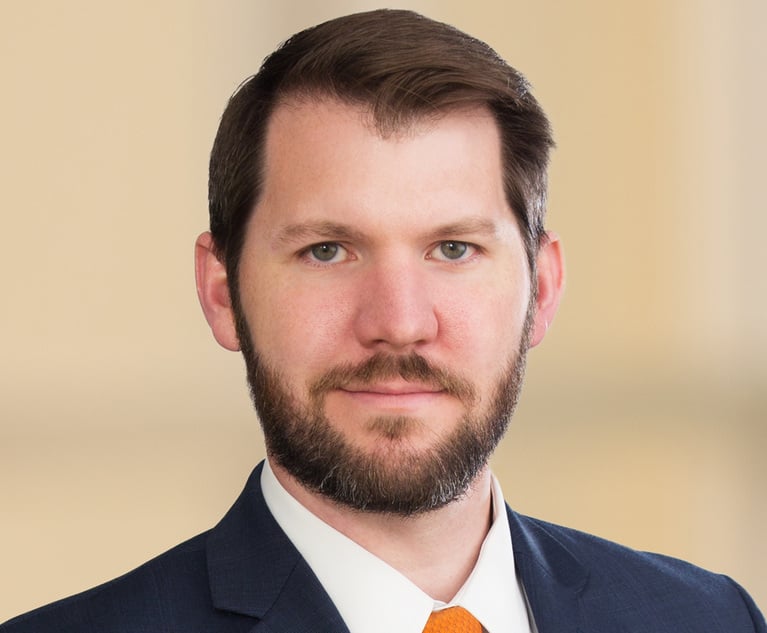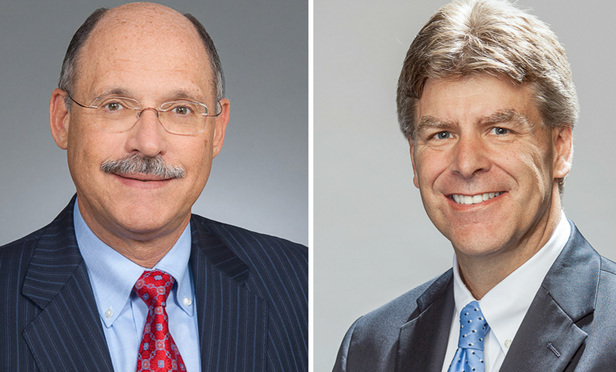K&L Gates picks two partners to succeed long-serving chief Kalis
US firm appoints non-exec chair and global managing partner
September 20, 2016 at 04:34 AM
3 minute read
The original version of this story was published on Law.com
K&L Gates has selected two lawyers to succeed chair and global managing partner Peter Kalis, who is stepping down early next year after two decades as leader of the firm.
Michael Caccese (pictured above left), who heads the firm's investment management practice, will become non-executive chair, while long-serving general counsel James Segerdahl (pictured above right) will be global managing partner. The decision follows two months of deliberations involving the firm's 75-partner global management committee.
Caccese and Segerdahl, whose four-year terms begin in February, were selected in a unanimous vote, the firm said. They are both close confidants of Kalis and are seen as "stability" candidates within the firm.
During Kalis's five consecutive terms as leader, he steered the firm from a relatively sleepy Pittsburgh-based regional player into a global powerhouse on five continents, with 46 offices around the world.
Caccese currently holds the position of vice-chair for practice management, which was created last year in part to boost productivity. He served in both in-house and governmental capacities prior to joining K&L Gates' Boston office in 2001. A rainmaker in Kalis's mould, he is credited with building that 113-lawyer office as well as its 145-lawyer investment funds practice, one of the firm's most successful.
Segerdahl joined K&L Gates' Pittsburgh office in 1987 directly out of law school and is a co-founder of its insurance coverage practice. As a general counsel and, since 2013, a vice-chair, he is popular within the firm, former partners said – a factor that will help him in the more inward-facing, day-to-day role of chief executive officer and global managing partner.
The selection of two partners to lead the firm suggests that Kalis's role had grown too large for one person to fill. "Mike Caccese and I have enormous shoes to fill in succeeding Pete Kalis," Segerdahl said in a statement.
The pair's initial challenges will be to stem departures, which have picked up in the past year, and to lift global profitability.
Since 2008, as recounted this spring in a profile in The American Lawyer, revenue per lawyer has drifted from $620,000 to $575,000 in 2015, leaving the firm near the bottom of the Am Law 100 on that metric. During the same time, average profits per partner (PPP) have been flat, varying little from $855,000 at the beginning of the financial crisis in 2007. In 2015, PPP was $870,000, up 4.8% from the previous year, but a drop of 16.65 in equity partner headcount was largely responsible.
The firm grossed $1.065bn last year, ranking it 24th in total revenues, according to the Am Law 100.
- For more, see Hit with defections, K&L Gates stays the course
This content has been archived. It is available through our partners, LexisNexis® and Bloomberg Law.
To view this content, please continue to their sites.
Not a Lexis Subscriber?
Subscribe Now
Not a Bloomberg Law Subscriber?
Subscribe Now
NOT FOR REPRINT
© 2025 ALM Global, LLC, All Rights Reserved. Request academic re-use from www.copyright.com. All other uses, submit a request to [email protected]. For more information visit Asset & Logo Licensing.
You Might Like
View All
How I Made Office Managing Partner: 'Don’t Be an Opportunity Killer,' Says Thomas Haskins of Barnes & Thornburg


White & Case Crosses $4M in PEP, $3B in Revenue in 'Breakthrough Year'
6 minute read
From Laggards to Tech Founders: Law Firm Innovation Is Flourishing
Trending Stories
Who Got The Work
J. Brugh Lower of Gibbons has entered an appearance for industrial equipment supplier Devco Corporation in a pending trademark infringement lawsuit. The suit, accusing the defendant of selling knock-off Graco products, was filed Dec. 18 in New Jersey District Court by Rivkin Radler on behalf of Graco Inc. and Graco Minnesota. The case, assigned to U.S. District Judge Zahid N. Quraishi, is 3:24-cv-11294, Graco Inc. et al v. Devco Corporation.
Who Got The Work
Rebecca Maller-Stein and Kent A. Yalowitz of Arnold & Porter Kaye Scholer have entered their appearances for Hanaco Venture Capital and its executives, Lior Prosor and David Frankel, in a pending securities lawsuit. The action, filed on Dec. 24 in New York Southern District Court by Zell, Aron & Co. on behalf of Goldeneye Advisors, accuses the defendants of negligently and fraudulently managing the plaintiff's $1 million investment. The case, assigned to U.S. District Judge Vernon S. Broderick, is 1:24-cv-09918, Goldeneye Advisors, LLC v. Hanaco Venture Capital, Ltd. et al.
Who Got The Work
Attorneys from A&O Shearman has stepped in as defense counsel for Toronto-Dominion Bank and other defendants in a pending securities class action. The suit, filed Dec. 11 in New York Southern District Court by Bleichmar Fonti & Auld, accuses the defendants of concealing the bank's 'pervasive' deficiencies in regards to its compliance with the Bank Secrecy Act and the quality of its anti-money laundering controls. The case, assigned to U.S. District Judge Arun Subramanian, is 1:24-cv-09445, Gonzalez v. The Toronto-Dominion Bank et al.
Who Got The Work
Crown Castle International, a Pennsylvania company providing shared communications infrastructure, has turned to Luke D. Wolf of Gordon Rees Scully Mansukhani to fend off a pending breach-of-contract lawsuit. The court action, filed Nov. 25 in Michigan Eastern District Court by Hooper Hathaway PC on behalf of The Town Residences LLC, accuses Crown Castle of failing to transfer approximately $30,000 in utility payments from T-Mobile in breach of a roof-top lease and assignment agreement. The case, assigned to U.S. District Judge Susan K. Declercq, is 2:24-cv-13131, The Town Residences LLC v. T-Mobile US, Inc. et al.
Who Got The Work
Wilfred P. Coronato and Daniel M. Schwartz of McCarter & English have stepped in as defense counsel to Electrolux Home Products Inc. in a pending product liability lawsuit. The court action, filed Nov. 26 in New York Eastern District Court by Poulos Lopiccolo PC and Nagel Rice LLP on behalf of David Stern, alleges that the defendant's refrigerators’ drawers and shelving repeatedly break and fall apart within months after purchase. The case, assigned to U.S. District Judge Joan M. Azrack, is 2:24-cv-08204, Stern v. Electrolux Home Products, Inc.
Featured Firms
Law Offices of Gary Martin Hays & Associates, P.C.
(470) 294-1674
Law Offices of Mark E. Salomone
(857) 444-6468
Smith & Hassler
(713) 739-1250









